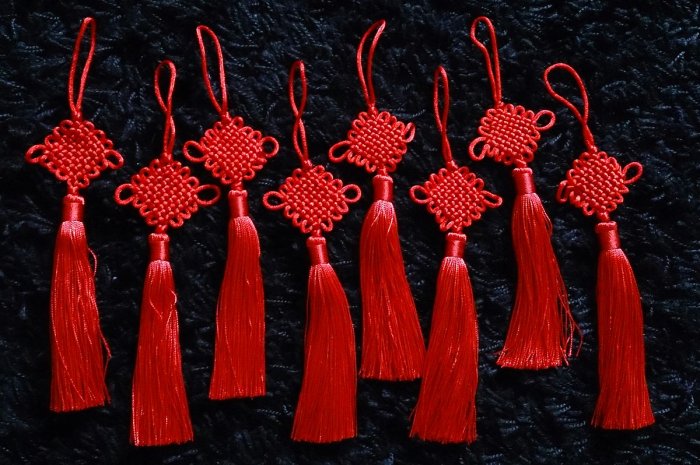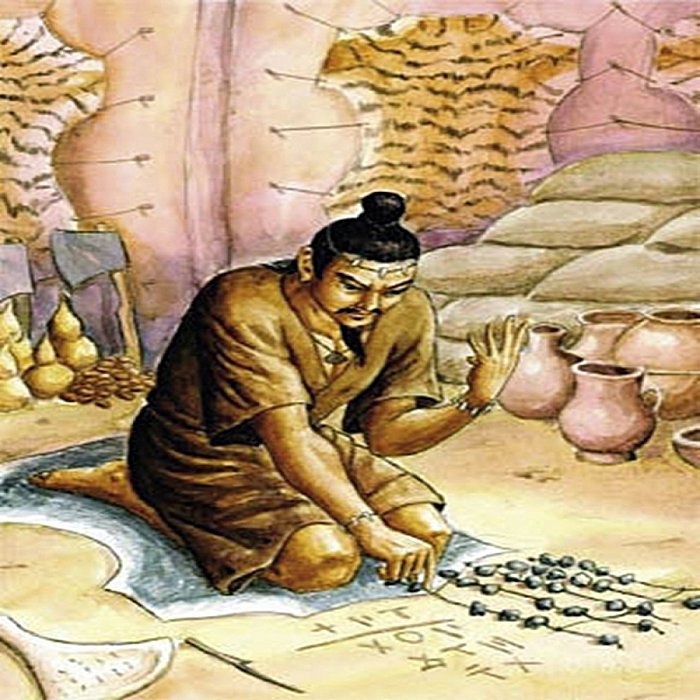Ancient Chinese Version Of Quipu -Tradition Of Tying Knots Dates Back To Antiquity
A. Sutherland - AncientPages.com - The use of the “quipu” for accounting purposes has been predominantly attributed to the Inca culture of Peru; however, documented evidence shows that early Hawaiians and ancient Chinese used it much earlier.
Today we describe, Chinese knots (the art of tying knots), which has its roots in antiquity. It is a decorative handicraft art that was first popularized in the Tang and Song Dynasty (960-1279 CE) and continued to flourish and reached zenith of its popularity during the Qing dynasty (1644–1911) of China.
History Of Chinese Knots
Knotting continued to flourish up until about the end of imperial China, but during the period from 1912 to the end of the Chinese Cultural Revolution in 1976, the art of knotting was almost lost in China.
Only few examples of prehistoric Chinese knotting exist today and they are recognized on bronze vessels dated to Warring States period (481–221 BC); two other rare examples are Buddhist carvings of the Northern Dynasties period (317–581) and knotting depicted on silk paintings from the Western Han period (206 BC–6 CE).
Except for archaeological findings, important philosophical works mention the use of knotted string records in China. In antiquity knotted cords served for the administration of affairs, and much later, they were replaced by writing.
According to the historical literature of "Book of Changes", and the "Annotations of The Book of Changes" by Zheng Xuan, (127–200), an influential Chinese commentator and Confucian scholar near the end of the Han Dynasty, knots were used to confirm the legal meaning of contract and agreement.
In the writings of Confucius (551-479 BC), it says that “the men of antiquity used knotted cords to convey their orders; those who succeeded them substituted signs or figures for these cords.”
Before the accession of the Emperor Fo-hi (3300 BC) it is said that the Chinese were not acquainted with writing and used quipos…”
Many Craftsmen, Sophisticated Techniques And Elaborate Patterns
The knot techniques evolved systematically over the millennia-long period of time and became extremely sophisticated containing intricate patterns.
In the dynastic periods, many craftsmen were stationed in the court and outside the court to create cords and knots in order to meet the increasing demand for them at various places of the court. Cord, knot and tassels were first made separately and combined later.
Features Of Chinese Knots
All Chinese knots are symmetrical, right, left, and up and down. They are also three-dimensional and consist of two layers of cord, with an empty space in between
Interestingly, they are made with one single string!
See also:
Secrets Of Quipu – One Of The Most Mysterious Phenomena That Existed In Odd Number Of Dimensions
I Ching – The Book of Changes – World’s Oldest Book Of Wisdom Used To Predict Future Events
Master Kong Confucius: Great Philosopher And ‘Teacher Of All Teachers’ Ahead Of His Time
All knots in this country are divided in two groups: auspicious – for use in temples or by monks who want to ward off the evil powers or turn misfortune into good fortune; and dressing knots patterns , used as bracelets and necklaces or other pieces of knot jewelry.
Symbolic Meaning Of Knot In Chinese Culture
Already in prehistoric times, Chinese knots were a symbol of harmony, strength, unity and love.
Many popular Chinese phrases contain the Chinse character for knot, which is “jie he” (come together); “jie hun” (get married); “jie fa fu qui” (husband and wife by first marriage) and many more.
 Eight examples of one traditional Chinese knot. Image credit: Wikipedia
Eight examples of one traditional Chinese knot. Image credit: Wikipedia
In the distant past, people made knots with rope to record important events.
In ancient Chinese tradition, “rope” is almost the same as god in Chinese, therefore, it was widely worshiped and during the Tang and Song dynasties, rope-made knots became important ornaments tied to clothes with knotted strings. These ornaments had even their special names with deeper meaning.
The traditional color of knots is red, because this color means “luck” in China.
The art of tying knots spread to neighboring countries, such as Korea, Japan and Hong Kong.
Written by – A. Sutherland AncientPages.com Staff Writer
Copyright © AncientPages.com All rights reserved. This material may not be published, broadcast, rewritten or redistributed in whole or part without the express written permission of AncientPages.com
Expand for referencesLydia Chen - The Complete Book of Chinese Knotting: A Compendium of Techniques and Variations
Prehistoric America - AvMarquis de Nadaillac,Jean-François-Albert du
More From Ancient Pages
-
 North America’s New Snake Species Deepen Our Understanding Of Reptile Social Behavior And Development
Evolution | Aug 2, 2024
North America’s New Snake Species Deepen Our Understanding Of Reptile Social Behavior And Development
Evolution | Aug 2, 2024 -
 Underwater Drone Images Reveal Oldest Human-Made Structure In The Baltic Sea
Archaeology | Feb 13, 2024
Underwater Drone Images Reveal Oldest Human-Made Structure In The Baltic Sea
Archaeology | Feb 13, 2024 -
 Rediscovery Of Lost Tombs And Quarries On A British Military Base In Cyprus
Archaeology | Mar 7, 2024
Rediscovery Of Lost Tombs And Quarries On A British Military Base In Cyprus
Archaeology | Mar 7, 2024 -
 Bes: Egypt’s Intriguing Dwarf God Of Music, Warfare And Protector Against Snakes, Misfortune And Evil Spirits
Egyptian Mythology | Jul 31, 2016
Bes: Egypt’s Intriguing Dwarf God Of Music, Warfare And Protector Against Snakes, Misfortune And Evil Spirits
Egyptian Mythology | Jul 31, 2016 -
 Humans In Africa Fled To The Mountains During The Last Ice Age
Archaeology | Aug 9, 2019
Humans In Africa Fled To The Mountains During The Last Ice Age
Archaeology | Aug 9, 2019 -
 Mirpur Jain Temple: Stunning Artwork Of Ancient Craftsmen Of India
Featured Stories | May 17, 2021
Mirpur Jain Temple: Stunning Artwork Of Ancient Craftsmen Of India
Featured Stories | May 17, 2021 -
 Astronomically Aligned Temples And Pyramids Of Ancient World
Featured Stories | Dec 10, 2021
Astronomically Aligned Temples And Pyramids Of Ancient World
Featured Stories | Dec 10, 2021 -
 Livestock And Dairying Led To Dramatic Social Changes In Ancient Mongolia – New Study
Archaeology | May 11, 2022
Livestock And Dairying Led To Dramatic Social Changes In Ancient Mongolia – New Study
Archaeology | May 11, 2022 -
 Mysterious Lost Kingdom Of Urartu And Its Enigmatic History
Featured Stories | Jun 22, 2014
Mysterious Lost Kingdom Of Urartu And Its Enigmatic History
Featured Stories | Jun 22, 2014 -
 Largest Figurine Workshop Yet Discovered In The Maya World
Archaeology | Apr 30, 2019
Largest Figurine Workshop Yet Discovered In The Maya World
Archaeology | Apr 30, 2019 -
 Connection Between Viruses And Ancestors Of All Complex Life Has Been Found
Archaeology | Jul 1, 2022
Connection Between Viruses And Ancestors Of All Complex Life Has Been Found
Archaeology | Jul 1, 2022 -
 World’s Oldest Recorded Solar Eclipse Re-Writes History Of Egyptian Pharaohs
Archaeology | Oct 30, 2017
World’s Oldest Recorded Solar Eclipse Re-Writes History Of Egyptian Pharaohs
Archaeology | Oct 30, 2017 -
 3D Scans Reveal Secrets Of Rare Ancient Canoe From Lake Mendota In Wisconsin
Archaeology | Jun 3, 2022
3D Scans Reveal Secrets Of Rare Ancient Canoe From Lake Mendota In Wisconsin
Archaeology | Jun 3, 2022 -
 ‘Impossible’ Advanced Ancient Technology In Mesopotamia – Evidence Of Other-Worldly Interaction?
Ancient Mysteries | May 24, 2021
‘Impossible’ Advanced Ancient Technology In Mesopotamia – Evidence Of Other-Worldly Interaction?
Ancient Mysteries | May 24, 2021 -
 Did Our Ancestors Know About Artificial Intelligence?
Ancient Technology | Sep 2, 2015
Did Our Ancestors Know About Artificial Intelligence?
Ancient Technology | Sep 2, 2015 -
 Unique Maya Center Of Copán With History Recorded In 2500 Hieroglyphics
Civilizations | Nov 7, 2018
Unique Maya Center Of Copán With History Recorded In 2500 Hieroglyphics
Civilizations | Nov 7, 2018 -
 Unseen 3,000-Year-Old Inscription On Biblical-Era Piece Of Pottery Deciphered By Researchers
Archaeology | Jun 21, 2017
Unseen 3,000-Year-Old Inscription On Biblical-Era Piece Of Pottery Deciphered By Researchers
Archaeology | Jun 21, 2017 -
 Was Napoleon Bonaparte Defeated At Waterloo Because Of Volcanic Eruption?
Archaeology | Aug 22, 2018
Was Napoleon Bonaparte Defeated At Waterloo Because Of Volcanic Eruption?
Archaeology | Aug 22, 2018 -
 Astronomically Aligned Pyramidal Buildings Of America’s Oldest City Reveal How Its Builders Apprehended Space And Time
Archaeology | Apr 15, 2021
Astronomically Aligned Pyramidal Buildings Of America’s Oldest City Reveal How Its Builders Apprehended Space And Time
Archaeology | Apr 15, 2021 -
 Island Archaeology Could Be A Model For Space Exploration
Archaeology | Nov 14, 2022
Island Archaeology Could Be A Model For Space Exploration
Archaeology | Nov 14, 2022


